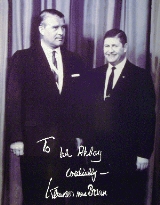
Ismail Akbay
Encyclopedia

Turkish people
Turkish people, also known as the "Turks" , are an ethnic group primarily living in Turkey and in the former lands of the Ottoman Empire where Turkish minorities had been established in Bulgaria, Cyprus, Bosnia and Herzegovina, Georgia, Greece, Kosovo, Macedonia, and Romania...
who worked for NASA
NASA
The National Aeronautics and Space Administration is the agency of the United States government that is responsible for the nation's civilian space program and for aeronautics and aerospace research...
. He was born in Mudanya
Mudanya
Mudanya , is a town and district of Bursa Province in the Marmara region of Turkey. It is located on the Gulf of Gemlik, part of the south coast of the Sea of Marmara. As of 1911, it was connected with Bursa by a railway and a carriage road, and with Istanbul by steamers...
(Tirilye-Zeytinbağı
Zeytinbagi
Zeytinbağı is a town in Bursa Province, Mudanya, Turkey, situated west of Mudanya. Trilye is a quaint township along the Marmara Sea shoreline.The area, which was inhabited since 5th Century BC, was known by the names such as “trigleia”, “bryllion” and “trilya” in the history...
) near Bursa, Turkey
Turkey
Turkey , known officially as the Republic of Turkey , is a Eurasian country located in Western Asia and in East Thrace in Southeastern Europe...
on October 17, 1930. Early on, Akbay was recognized as a gifted child with exceptional mental aptitude. He graduated from Bursa Erkek Lisesi and Haydarpaşa Lisesi before choosing to move to the United States. In 1956, he received a B.S. degree in Engineering Physics from the University of Tennessee
University of Tennessee
The University of Tennessee is a public land-grant university headquartered at Knoxville, Tennessee, United States...
.
Akbay was personally selected by Dr. Wernher von Braun
Wernher von Braun
Wernher Magnus Maximilian, Freiherr von Braun was a German rocket scientist, aerospace engineer, space architect, and one of the leading figures in the development of rocket technology in Nazi Germany during World War II and in the United States after that.A former member of the Nazi party,...
, the famous Moon Rocket Scientist, to be the lead aerospace engineer for the F1 Engine Integration on the Apollo Saturn V-S1C Rocket. Mr. Akbay also spearheaded the Saturn 1B/H-1 Engine Integration for the Apollo-Soyuz Rendezvous Mission. Between 1963 and 1975, Akbay served in various managerial capacities during NASA’s Apollo, Skylab
Skylab
Skylab was a space station launched and operated by NASA, the space agency of the United States. Skylab orbited the Earth from 1973 to 1979, and included a workshop, a solar observatory, and other systems. It was launched unmanned by a modified Saturn V rocket, with a mass of...
and Apollo-Soyuz projects.
His 31-year career at NASA earned him recognition as one of American’s early space pioneers. In Turkey, at the end of the 1960s, newspaper headlines heralded him as the "Turkish Villager Who Helped Put Man on the Moon".
After his career with NASA, Akbay worked on the transfer of space technology to the U.S. private sector and the commercialization of other federally-funded technologies.
During a meeting in 1996 about technology transfer, Akbay introduced Kaya Tuncer to the idea of building a Space Camp at the Aegean Free Zone. Until his untimely death in July 2003, Akbay was an enthusiastic supporter of Space Camp Turkey
Space Camp Turkey
Space Camp Turkey uses space and space technology with the aim to motivate and educate children aged 9-15 in the fields of astronomy and science. Through simulations, it improves youth self-confidence, teamwork and communication skills...
, attending its opening ceremony in June 2000 and following its progress and developments.

